Best Ethernet Switches (L2 Managed)
| 1. Zyxel XS1930-12HP Multi-Gigabit Ethernet Switch | 2. Engenius ECS2512FP Multi-Gigabit Ethernet Switch |
 |
 |
| Read More | Read More |
 |
 |
| 3. ZyXEL GS1900-16 Ethernet Switch | 4. FS S2800-8T Ethernet Switch | 5. TP-Link TL-SG2210P Ethernet Switch |
 |
 |
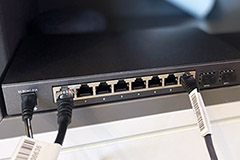 |
| Read More | Read More | Read More |
 |
 |
1. Zyxel XS1930-12HP Multi-Gigabit Ethernet PoE Switch
Read the full review of the Zyxel XS1930-12HP
After the WiFi 6 standard was launched, it was obvious that the Gigabit Ethernet switches will bottleneck the network when using wireless access points that come equipped with multi-Gigabit ports, so the SMB market needed to shift its focus towards the enterprise-solutions which can be more expensive. Thankfully, Zyxel came to the rescue with its XS1930-12HP which offers ten 10GbE ports (that also support 2.5GbE and 5GbE connections).
But what sets it apart from its competitors is the PoE++ technology which is suitable for more power-hungry devices, such as the Zyxel WAX650S which can operate at its full power only when connected to this type of Ethernet switches. For this particular model, the power budget is 375W and its worth noting that, similarly to the GS1920-8HP, the XS1930-12HP is a hybrid switch which means that it supports full integration with the Nebula Cloud Center and it can work in stand-alone mode.
When put next to the GS1920-8HP, the Zyxel XS1930-12HP is significantly larger (it needs two fans to remain cool), but it does follow the same guidelines as the other switches on the market, which means that we’re dealing with a rectangular case covered by a black matte finish all around and with a black glossy front panel. That being said, the XS1930-12HP is just as large as the NSW100-10P, measuring 12.99 x 9.06 x 1.75 inches and, while Zyxel has added four silicone pads that you can add to the bottom of the switch (to keep it on a desk or shelf), since it’s not a passive-cooled device, it’s better to mount it on a rack (the manufacturer has added a mounting kit in the package).
I really enjoyed the compact size of the GS1920-8HP but it did have some trouble remaining cool (especially during the summer, when I tested the device), so it’s not ideal to rely on passive cooling with this type of devices (especially if the PSU is internal). As expected, the XS1930-12HP needs two fans which do a great job at keeping the case cool despite the number of connected PoE clients. You do need to keep in mind that the fans aren’t that quiet and for this reason, you may want to keep the Ethernet switch mounted in a rack or within a special enclosure.
The front of the XS1930-12HP is occupied by eight PoE++ 10Gbps LAN ports followed by two non-PoE 10Gbps LAN ports and two 10Gbps SFP+ ports (for connecting a couple of fiber optic transceivers – SFP+ transceiver or Direct Attach Copper). To the left of the PoE++ ports block, Zyxel has positioned the LED indicators. First there’s the the Power LED, the System LED, the Cloud LED (will get green when the switch is connected to the NCC) and a Locator LED (to help you identify the switch if it has been installed along many other devices).
Next to these LEDs, there are two additional blocks of indicators, two for each of the eight PoE ports, one indicating the status of the Link/Activity (will flash blue when the data is transmitted at 10Gbps, purple at 5Gbps, light blue at 2.5Gbps, green when the data is transmitted on a 1,000 Mbps connection and will flash yellow if the data is transmitted on a connection of either 10 or 100 Mbps) and the other will show the status of the PoE (blue indicates that the power supplied meets the 802.3bt standard, green indicates the 802.3ad standard and amber shows that it meets the 802.3af standard).
Note: On the rear side of the switch, there’s an AC Input 100-240VAC 50/50Hz 2.55A Max power connector, a grounding screw and a Kensington lock slot.
Inside the case, the Zyxel XS1930-12HP is equipped with a Broadcom BCM59121B0KMLG power sourcing equipment controller, 256 MB DDR3 RAM (from Winbond), 256 Mb of storage from Macronix (MXIC MX25L25645G), as well as another 4Mb of storage memory also from Macronix (MXIC 25L4006E). Furthermore, the Zyxel XS1930-12HP has a switching capacity of 200 Gbps, 16K MAC address table and a forwarding rate of 148.8 Mbps.
The hardware installation of the XS1930-12HP is similar to any other Ethernet switch, just connect it to a power source and a router and then start adding clients, but, since this is an L2 managed switch, we do get to configure various aspects of the network. The XS1930-12HP can be immediately adopted to the Nebula Cloud Center, but it was also built to work as a purely stand-alone device. To access the interface, you need to know the IP address of the Ethernet switch and to enter it into the URL of a browser.
After you finish the initial configuration process, you will be greeted by a simple UI, but don’t be fooled by its minimalist look, since you do get a lot of options for a in-depth configuration. Some of them are the Static Multicast Forwarding, Port Mirroring, L2 Protocol Tunneling, PPPoE (Intermediate Agent), ARP Setup and more.
If you want to use the XS1930-12HP along with other Zyxel devices, then you need to register an account on the NCC (go to https://nebula.zyxel.com) and, after creating a new Organization and Site, you will gain access to the full user interface (yes, you can create multiple sites for an easy device deployment).
The Nebula Control Center is slightly differently organized than the UniFi controller from Ubiquiti or the CloudTrax from OpenMesh, having its main sections divided into two groups of options, Monitor and Configure. Under Monitor, you can view a list of all connected Switches and, by clicking on the Zyxel XS1930-12HP, it will summon a dedicated window where you can view some stats about the device and, towards the bottom, you will see a graphical representation of the ports.
Click on the ports to configure them – includes Static link aggregation and LACP, Rapid Spanning Tree Protocol, STP Guard, Port isolation, Loop guard and the Storm control. Furthermore, under Monitor you can view all the connected Clients, consult the Event log, view the IPTV Report, check the Summary Report and more.
Under the Configure group of options, you can set the Advanced IGMP (includes the possibility to assign specific VLANs or Auto-detect for the IGMP snooping VLAN), set the RADIUS policy, configure the PoE schedule or access the more in-depth Switch configuration. It includes configuring the Management VLAN, the STP, the QoS, add Port mirroring, Authentication servers, enable the Voice VLAN, the DHCP Server Guard and more.
Additionally, Zyxel has also made available a mobile application called Nebula (Android OS and iOS), where you can add new devices to the Cloud, view various stats and perform some basic configuration, but it is far more limited in functionality than the web-based NCC.
Note: Inside the package, you can find the XS1930-12HP Multi-Gigabit Ethernet PoE Switch unit, the AC adapter, the wall-mounting kit, the silicone footpads and the installation guide.
2. Engenius ECS2512FP Multi-Gigabit Cloud Managed Switch
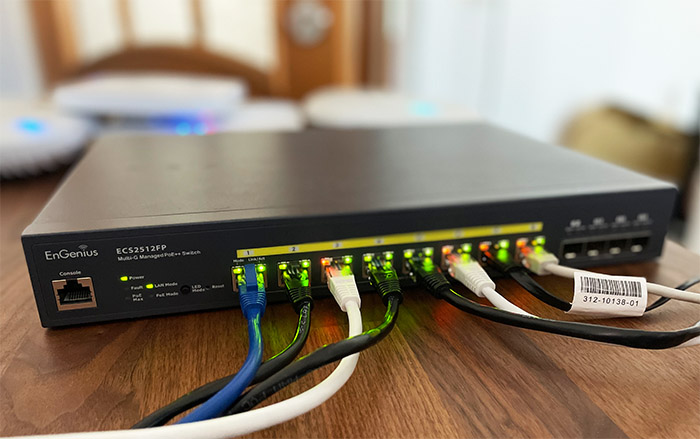
Read the full review of the Engenius ECS2512FP
The Engenius ECS2512FP is part of the multi-Gigabit series and, while it may be presented as the entry-level model, it offers some advanced features that would be suitable not only for SMBs, but even to some smaller enterprise networks. All Ethernet ports support connections up to 2.5GbE, there are four 10Gbps SFP+ slots for high speed fiber optics connections between long-distance networks and the support for the Cloud management platform remains available.
And it’s interesting to see the direction that EnGenius has taken with its product line, especially after seeing the significant improvements that they made for remote management and rogue AP detection with the newer ECW220S and the ECW230S. In terms of design, the EnGenius ECS2512FP has kept the characteristic look of the other switches on the market, so it features a metallic rectangular case covered by a dark matte finish (doesn’t retain fingerprints).
In terms of size, the Engenius ECS2512FP measures 13.0 x 9.0 x 1.7 inches which means that it’s built to be rack-mountable and yes, you do get some rack-ears that you need to attach on the sides. Certainly, you can leave the Ethernet switch on a desk – there are four silicone feet that you need to attach, but it’s a very noisy device, so I suggest against it.
Indeed, the Engenius ECS2512FP has a small fan that ramps up immediately after powering on the unit and it just stays that way, no adjustment in accordance to the load. Surely, the downside is the noise, but the upside is that the Engenius ECS2512FP runs very cool. And it’s not only when you keep it in the open, no, I have put the ECW230S on top of it and left it for hours and yes, the AP got very hot, but not the switch. It remained cool and noisy.
On the front side of the Engenius ECS2512FP multi-Gigabit switch, you can find almost all the ports and LED indicators: first, there’s the Power LED, followed by the Fault LED (indicates an error) and PoE Max (if it’s turned on, you have exceeded the maximum allowed PoE budget – 240W). Additionally, there are two LED lights which show if the LAN Mode or the PoE Mode is enabled, along with the LED mode button which switches between these two modes and a small Reset button (for going back to the factory default settings).
Next, you’ll find eight 10/100/1000/2500 Base-T GbE Ethernet ports that can be used to connect your PoE devices (there’s support for 802.3af/at/bt PoE++ standards, with a limit to 60W, which is more than enough). On the rear side of the device, you’re going to find the power adapter and a grounding screw.
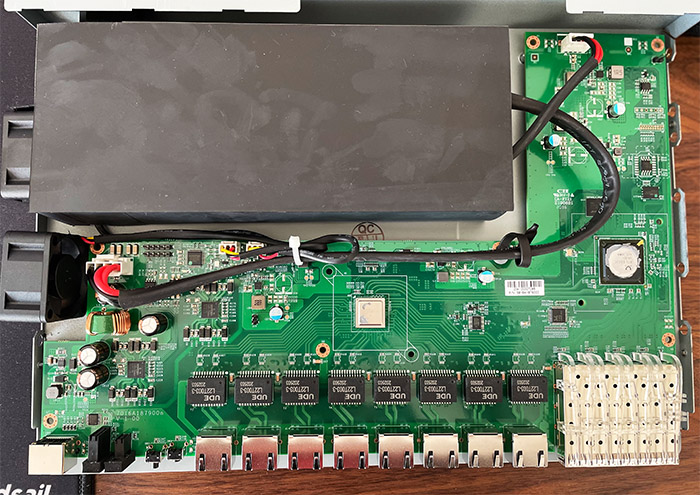
Inside the case, Engenius ECS2512FP is equipped with a Broadcom BCM50998EB0KFSBG CPU, 512MB of RAM from Winbond (W634GU6NB-11), 128MB flash storage from MXIC (X195210 MX35LF1GE4AB-Z4I) and two Broadcom BCM59121B0KMLG switch chipsets. Furthermore, the switching capacity of the Engenius ECS2512FP is 120 Gbps and it supports 9K Jumbo Frames.
Hardware-wise, the switch is well built and has decent internal components, but one of the main selling points is the compatibility with the Cloud management platform, allowing the user to configure and monitor the network (or networks) remotely. After registering a new account on the Cloud and adding the switch to a new network, you’ll be able to configure multiple Ethernet switches along with a high number of wireless access points and SkyKey appliances (for controlling non-Cloud APs). And the user interface has made it quite easy, displaying a graphical representation of all connected devices.
The switch-related features include the ability to see and manage the PoE budget per port, as well as to configure the VLAN (and Voice VLAN), the STP, QoS, the Flow Control, Port Trunking (Static or LACP), Port Mirroring and a lot more.
You can also use the mobile application which is a bit more limited, but will allow you to make some amount of changes to your sites, until you can access the full web-based Cloud management software. And I have tested a few other Ethernet switches, such as the Engenius ECS1008P which had a very basic local management utility, but that’s not really the case with the Engenius ECS2512FP.
Not at all, you get pretty much the entire feature set as on the Cloud, minus the ability to manage and monitor multiple devices at the same time on multiple sites. Then again, not all system admins need such a large infrastructure, so yes, the rich local management is definitely a major selling point.
3. ZyXEL GS1920-8HP 10-Port Smart Ethernet Switch
Read the full review of the Zyxel GS1920-8HPv2
The Zyxel GS1920-8HP is the first 8-port PoE switch released by the Chinese manufacturer, offering a very compact case considering its features, which includes the 130W PoE budget, a couple of SFP ports, lots of advanced SMB-suitable capabilities and most importantly, the full integration to the Nebula Cloud management platform (it will seamlessly work along other Cloud-compatible Zyxel devices), as well as the possibility to be fully configured in stand-alone mode (I know that the Ethernet switch is advertised as being the second version, but that’s for making it easier to be discerned from the previous generation of GS1920 switches).
Note: The Zyxel GS1920-8HPv2 is a hybrid Cloud Ethernet switch (part of the NebulaFlex series), but the manufacturer also offers a ‘purely’ Cloud-managed Ethernet switch series which includes the slightly more powerful NSW100-10P.
Design-wise, the ZyXEL GS1920-8HP is a relatively small and compact device, having a metallic rectangular body covered by a black matte finish. And that’s pretty much the standard blueprint for this type of devices, but to add a differentiating element, Zyxel has added a carbon-fiber-like front panel (covered by a glossy finish).
One of the most compact PoE switches is the unmanaged TRENDnet TPE-LG80, but, since it’s more powerful, the GS1920-8HP needed to be a bit bigger, but it’s still impressively compact especially when put next to its Cloud-only sibling, the NSW100-10P. That being said, the GS1920-8HP measures 10.51 x 6.38 x 1.73 inches and it weighs 4.19 lb, so it’s quite heavy considering its size.
This means that you won’t really have a problem placing it anywhere in the room (on a desk or on a shelf), but if space is very important (especially when dealing with crowded business offices), ZyXEL offers the possibility to mount the switch on the wall (use the two screws provided in the box) and, additionally, you get the option to mount it on a rack (there are two mounting brackets included in the package to help you), just be careful to not obstruct the airflow of the switch.
The ZyXEL GS1920-8HP relies on passive cooling, so it lacks the loud fans that some of us have come to dread. On the left and the right side of the switch there are some ventilation grills that should ensure a proper airflow, as well as on the top side (where there are some large cut-outs), but bear in mind that the GS1920-8HP does have the tendency to get a bit warm (and sometimes hot to the touch, unlike the fan-cooled NSW100-10P).
The bottom side of the switch is home to four feet (they come separately and you have to stick them to the bottom of the device), two holes for wall-mounting and some labels (with the product name, model number and the power consumption).
On the front side of the ZyXEL GS1920-8HP, you can find the 10 10/100/1000Mbps Gigabit Ethernet BASE-T ports positioned in two blocks, one consists of 8 PoE LAN ports and the other of two non-PoE LAN ports. On the left side of the ports, there are five PoE MAX Usage LEDs. These LEDs will light up as you add more PoE devices and draw more power – when less than 5% remains from the total budget, then the last LED will start flashing), as well as a LED for Power and a System LED (if it’s blinking, it means that the system is either rebooting or is performing self-diagnostic tests).
There also a Cloud LED (if it flashes green, then the device has not yet been registered to the Nebula Control Center, but a solid green shows that it’s registered to the NCC) and a Locator LED. Additionally, there two small LEDs showing the LINK/ACTIVITY for every port (if the green LED is blinking, it means that the system is transmitting and/or receiving data from a 100/1000 Mbps network, otherwise, if it’s on, it means that the link to a 100/1000Mbps network is up and running).
Underneath the block of LEDs, there is a recessed Reset button (accessible using a paper clip along with a Restore button to help you return the device to a previously saved configuration. On the rear side of the switch, there is a Power port (AC input 100-240VAC 50/60Hz 0.25A MAX), but there is no Power ON/OFF switch.
On the inside, ZyXEL has equipped the GS1920-8HP with a Broadcom BCM59121B0KWLG PoE Controller, a Texas Instruments TPS23754 IEEE 802.3at PoE controller, 128 MB of DDR3L SDRAM and 32 MB of IC Flash Memory. Furthermore, the ZyXEL GS1920-8HP has a switching capacity of 20 Gbps, a packet buffer of 1.5 million bytes, a forwarding rate of 15 Mbps and 16K MAC address table.
Setting up the GS1900-16 is very easy, all you have to do is connect the switch to a power supply and add up to 10 devices using Ethernet cables (and an additional of two using the SFP ports). Furthermore, ZyXEL gives you the option to configure your network using the standalone web-based user interface and to access it, you have to go to the IP address of the device, where you’ll be prompted to insert the user name and password (admin/1234).
Lastly, you have to click Login to access the utility (in case the IP address coincides with that of the router – the case when the IP is set to static – you can change it using the ZON utility). That being said, the UI looks a bit dated, but it offers all the features one may expect from a managed Ethernet switch. The menu on the left includes the Basic Setting (PoE Setup, DNS and Cloud Management) and the Advanced Applications.
These include the VLAN Configuration, Static MAC and Multicast Forwarding, Filtering and STP, the Bandwidth Control, Port Mirroring, Link Aggregation, Port Authentication, Port Security, Time Range, the Classifier, the Queuing Method, Loop Guard, Private LAN and more. There’s also the IP Application and the Management (to upgrade the Firmware, set the Remote Management, view the Port Status and more).
Since the ZyXEL GS1920-8HP is a hybrid Ethernet switch, it will also work seamlessly with the Nebula Control Center and the device can be registered using either the Nebula app (it offers a healthy amount of features but it is a bit more limited than the web-based NCC) or through the Nebula Control Center which is accessible through a web browser (to do, so, you need to register the switch from the Inventory section which is part of the Organization section).
After registering the GS1920-8HP, you will be able to see it along with some other stats on the Dashboard (part of the Site-Wide section). If you click on the Switch option (from the top menu), you will be able to Monitor and Configure the device. The Monitor group of settings includes a list of all connected switches, the Event Log and the Client list while the Configure group allows you to view the Switch ports, set up the IP filtering, the Advanced IGMP, the RADIUS Policy, the PoE Schedule and the Switch configuration.
Note: The ZyXEL GS1920-8HP is compatible with the following standards: IEEE 802.1Q, IEEE 802.3u, IEEE 802.1ab, IEEE 802.3az, IEEE 802.3af, IEEE 802.3at, IEEE 802.1p, IEEE 802.1x, IEEE 802.3AB, IEEE 802.3ad, IEEE 802.3w, IEEE 802.3X and IEEE 802.3s.
4. FS S2800S-8T Smart Managed Ethernet Switch

Read the full review of the FS S2800S-8T
FS doesn’t usually release compact Ethernet switches since their audience consists of SMBs and enterprise-level businesses which require rack installation. But the manufacturer did not want to leave the enthusiasts and the start-ups behind, so it decided that it needed to develop the FS S2800S-8T. We’re dealing with an ultra-compact switch that has a similar set of features to the beefier models from FS (such as the S3910-24TS), but, at the same time, it does lack a few technologies that some may deem mandatory.
Indeed, the FS S2800S-8T does not support PoE, nor can it be mounted in a rack. But, the user still gets the full FS software experience which resembles very closely that of Cisco, but at a way lower cost. And, despite being inexpensive, it seems that the FS hardware is surprisingly robust – just take a look at their fiber optic transceivers. The FS S2800S-8T is not just a compact Ethernet switch, it is actually the smallest switch that I tested so far and, since it measures 7.48 x 4.72 x 1.38 inches, it can almost be considered pocket size.

But, as I mentioned before, the consequence of ultra compactness is the loss of PoE and of the ability to be rack mounted. Even so, there are two holes on the bottom to mount the device on a wall, so, if you don’t want to use a tray, it doesn’t really have to take up space from the desk. PoE usually rises the internal temperature of an Ethernet switch, but since it’s missing this ability, does the small size have an impact on the temperature management?
We can see that the case is metallic, but there are enough ventilation holes to keep the temperature in check (I have even added a thermal photo so you can see for yourself).
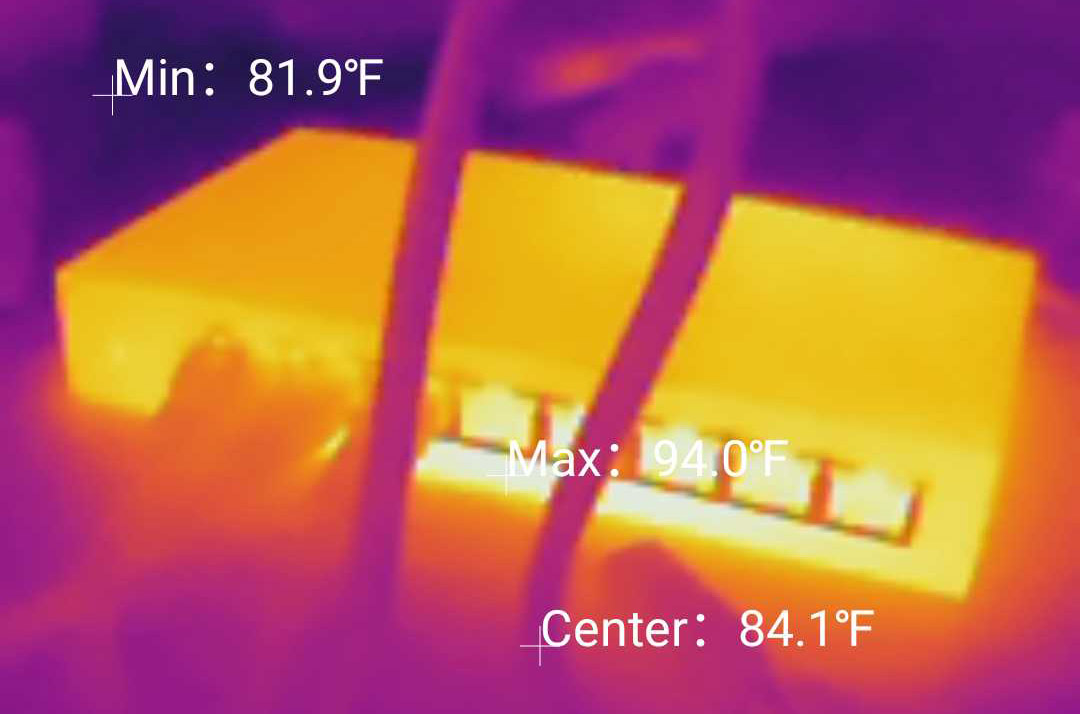
In terms of ports, the rear side of the switch only has the power port, while the Ethernet ports rest on the front side. There are eight in total, all Gigabit and each has two dedicated LEDs, one for showing the activity, the other for the connection. There is another LED for the Power and next to it, there is a Reset button for returning the switch to factory default settings.
As with all other switches that I tested, I opened the FS S2800S-8T and I was able to identify the Realtek RTL8380M switch chipset, I could also see the 128MB Winbond W631GG8NB-12 and 16MB Winbond 25Q128JVSQ of storage memory.
Even though the installation process is not really difficult, it’s not as straight forward as on other switches. That’s because the device has a preset static IP address and you will have to change it to dynamic, so it matches the subnet of your router or gateway. The GUI can be accessed via a web browser and, as with other FS switches, there is no mobile app, not that I miss it.

The interface offers a very good amount of features, from some basic ones to the more advanced options such as the Port Aggregation, Mirroring and Isolation, the VLAN and Port mode and the ability to create new VLANs (including Voice and Surveillance VLANs). Additionally, there were some security features, such as the DDOS Protection, the Access Control and more.
In terms of performance, I did run a LAN to LAN test where the throughput was 937Mbps upstream and 902Mbps downstream. But FS went far more in-depth and ran some tests using the ixia ixNetwork (which I don’t really have access due to cost). The results are really good considering the average latency was negligible.
5. TP-Link TL-SG2210P JetStream PoE Ethernet Switch
The TP-Link TL-SG2210P is part of the Smart Desktop switch series and, besides sporting a better PoE budget than the previous version (58W to 61W), the device now fully supports the Omada SDN. This way, the TP-Link TL-SG2210P has better security settings, improved VLAN and there are L2 and L2+ features available as well. Design-wise, the TP-Link TL-SG2210P has kept the same look for generations, featuring a rectangular case made of metal and, at 8.2 x 4.9 x 1.0 inches, the Ethernet switch is not rack-mountable.
And it’s a strange decision from TP-Link, but you can always simply use a tray (still not the ideal solution as you’ll see in a minute). In any case, there are no fans inside, so the TP-Link TL-SG2210P is silent and it also does decently well in terms of heat management.
Another design aspect that suggests we are dealing with a desktop-only Ethernet switch is the decision to put all the ports on one side and the LEDs on the other. So yes, the device will sit better either on the wall or on the desk.
The front side will show whether the maximum PoE budget has been reached and each port has its own set of LEDs, one showing the type of connection (10/100Mbps or Gigabit) and the other will let you know that you connected a PoE device. Be aware that there is a maximum of 30W available per port (PoE+), so the 61W total budget is a bit sad and barely suitable for an SMB. Then again, there are more powerful models under the same brand. It’s just that the TP-Link TL-SG2210P is more of an entry-level device.
Besides the eight Gigabit LAN ports, there are two SFP slots which also support up to 1 Gigabit, in case you want to interlink two networks via fiber. The TP-Link TL-SG2210P Ethernet switch does have a comprehensive local management interface which will allow you to check some switching options, such as LAG (LACP and Static LAG), port config, isolation and loopback detection. There’s also VLAN, QoS, CoS, bandwidth control and other.
But probably the most interesting features are the IPv4/IPv6 Routing Table, Static Routing, DHCP Service and Routing, all these being L3 features, so the TP-Link TL-SG2210P is edging on the truly managed switches territory.
The Omada SDN works in a similar manner to the Ubiquiti UniFi, so you do need to run an instance of the software all the time somewhere within your network. And yes, TP-Link has made available the OC200 and the OC300 for this exact reason, but it seems that it’s entirely possible to use Raspberry Pi as well. That being said, the Omada SDN offers pretty much the entire spectrum of features that we saw on the standalone mode, but the perk of using this platform is that you can apply a global set of settings on all the switches in the network/s.
Of course, it’s very much possible to adjust individual settings, but the idea is to easily monitor and configure more than one device at the same time. At the moment, TP-Link does not offer a Cloud platform (or the option to host the SDN), but you can use AWS (I think) to gain the option of remote control and monitoring.
Which I consider to be a vital element for a large organization with lots of networks all over the world. The Omada SDN is not yet there, but it’s growing up, so it will reach this point somewhere in the future.
Note: Inside the package, you can find the TP-Link TL-SG2210P switch unit, a Power cord, an Installation Guide and the rubber feet. Yes, there is no Ethernet cable.

Mark is a graduate in Computer Science, having gathered valuable experience over the years working in IT as a programmer. Mark is also the main tech writer for MBReviews.com, covering not only his passion, the networking devices, but also other cool electronic gadgets that you may find useful for your every day life.




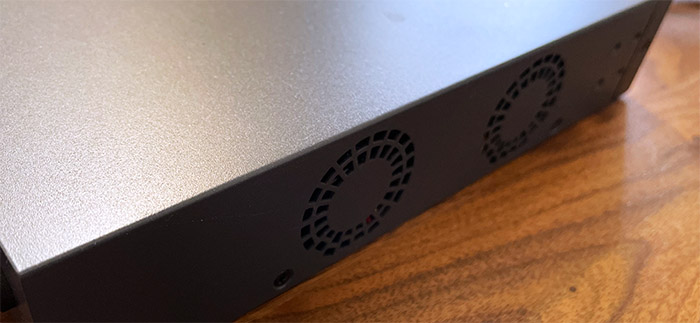


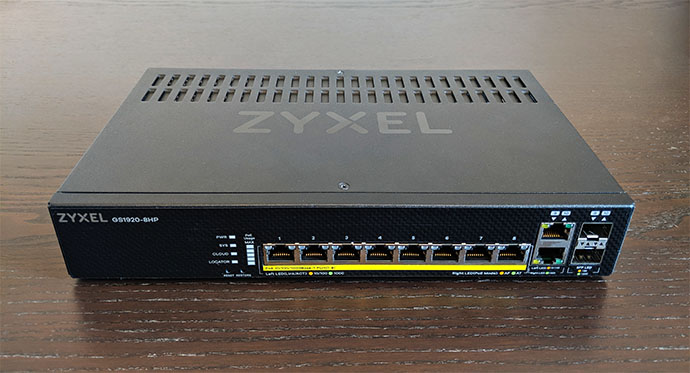


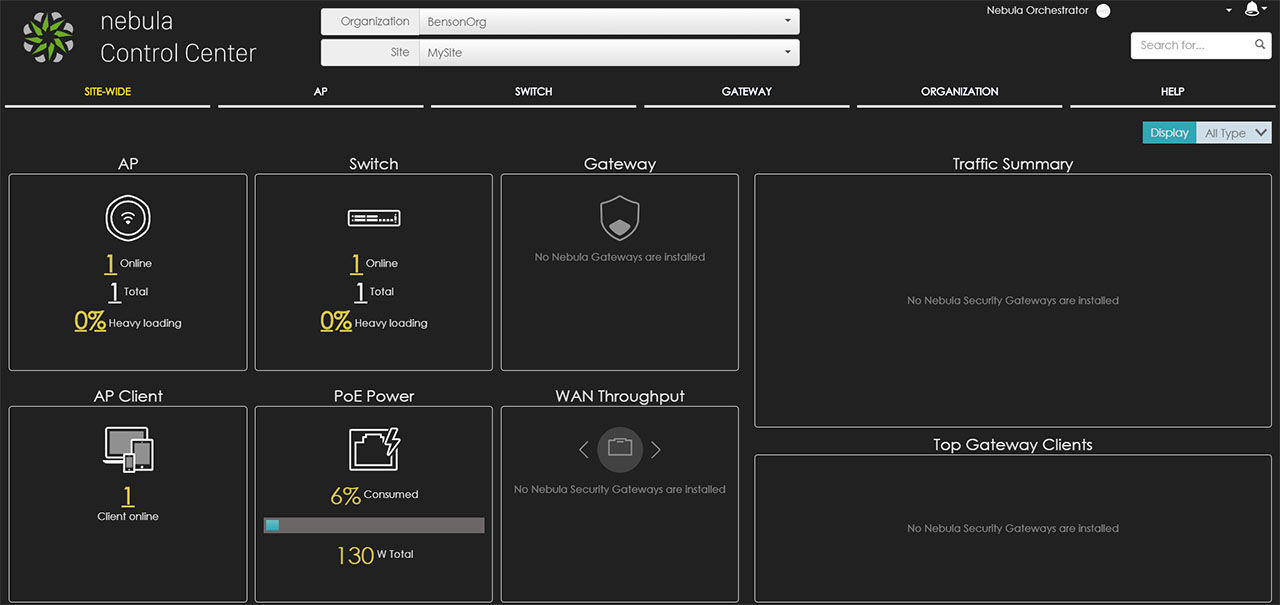


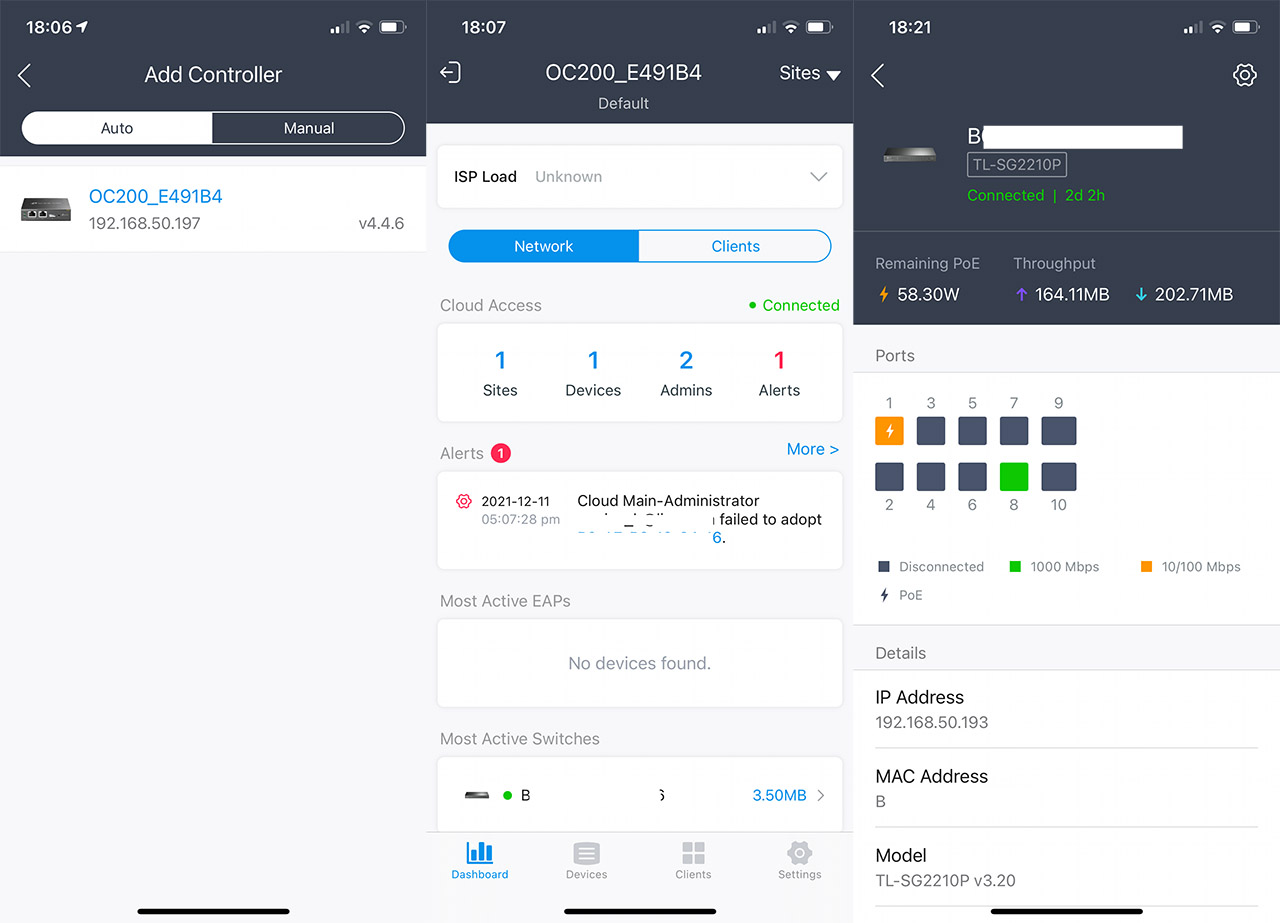
The article is OK as a broad brush review, although for the life of me, I don’t see how most of these are claimed or reviewed to be rack mount with seeing holes to attach the un-supplied mounting ears.
The article is big enough as it is, so I can’t go into detail with every device, but I have individually reviewed lots of Ethernet switches already (especially the L2 managed ones), so check those articles out for an in-depth dive.
Have you considered the Open Mesh Cloud PoE+ Switches and new G200 Router/Switch? (I don’t work for Open Mesh.. just liked your reviews and have used older Open Mesh products) Thanks
well i read your article and i really like it,please write one article in cisco switches like
CVRQSFPSFP10G